Abstract
Twenty-seven species of terrestrial isopods are recorded from the Maldive Islands (North Kaafu Atoll and Vaavu Atoll). One genus (Eubelinum) in the family Eubelidae and three species (Styloniscusmaldivensis, Eubelinumincertum, and Pseudodiploexochusindicus) are described as new, and 26 species are newly recorded from the archipelago. Ligia dentipes Budde-Lund, 1885 is also recorded from Sri Lanka and Seychelles. The poorly known species Tylosalbidus Budde-Lund, 1885 and Platyarthrus acropyga Chopra, 1924 are also illustrated. The composition and origin of the oniscidean fauna of the Maldives are briefly discussed.
http://zoobank.org/urn:lsid:zoobank.org:pub:ABD0E6EA-83FE-4F61-8B81-D3C8A0B23848
Introduction
The Maldives archipelago consists of about 1200 coral islands in the Indian Ocean grouped in a double chain of 26 atolls across the equator, oriented north-south, between latitudes 7°06′30″N and 0°41′48″S, and between longitudes 72°32′30″E and 73°45′54″E. The Maldive Islands are located in the Laccadive Sea on top of a submarine mountain range, the Chagos–Maldives–Laccadive Ridge, about 670 km south-west of Sri Lanka, 595 km south-west of India, and 550 km north of Chagos Islands. Islands are in general quite small with an average area of only 1–2 km2 and an average elevation of 1.5 m above mean sea level.
Little is known about the terrestrial isopods from the Maldives. Borradaile (Citation1901) recorded six species: Ligia exotica Roux, Citation1828, Porcellio maldivensisn. sp., Alloniscus maldivensisn. sp., Philoscia gracilis Budde-Lund, Citation1885, Philoscia sp., and Cubaris murina Brandt, Citation1833. According to Budde-Lund (Citation1913), only L. exotica and C. murina are correctly identified, while P.maldivensis probably corresponds to Agnara madagascariensis (Budde-Lund, Citation1885), and A. maldivensis to Alloniscus pigmentatus Budde-Lund, Citation1885. Unfortunately, it was not possible to locate Borradaile's material, so I was unable to re-examine and safely identify those specimens. However, the species are commented in the text. Ferrara and Taiti (Citation1985) recorded Alloniscus nicobaricus Budde-Lund, Citation1885 from the Maldives.
The terrestrial isopods listed in this paper were collected by S. Taiti during three trips to the atolls of North Kaafu (North Male) and Vaavu (Felidhu) in the years 1992, 1993 and 1994. The islands investigated in each atoll with their latitudes and longitudes (datum WGS84) are the following:
North Kaafu Atoll: Medhufinolhu (Reethi Rah) 4°30′46″N 73°22′15″E; Eriyadhoo 4°35′24″N 53°24′73″; Huraa 4°15′50″N 73°30′00″E; Kudabandos 4°35′24″N 73°24′53″E.
Vaavu Atoll: Fulidhoo 3°40′50″N 73°24′57″E; Alimathaa 3°35′37″N 73°29′52″E; Aarah 3°29′57″N 73°31′45″E; Hulhidhoo 3°29′36″N 73°31′58″E; Thinadhoo 3°29′15″N 73°32′17″E; Felidhoo 3°28′18″N 73°32′50″E; Foththeyo 3°27′16″N 73°45′31″E; Bodumohoraa 3°20′35″N 73°31′17″E; Rakeedhoo 3°18′54″N 73°28′12″E; Anbaraa 3°22′20″N 73°26′23″E; Vashugiri 3°37′48″N 73°22′40″E; Kudhiboli 3°38′12″N 73°21′55″E.
Abbreviations: MZUF, Museo di Storia Naturale dell'Università, Sezione di Zoologia “La Specola,” Florence, Italy; SMNS, Staatliches Museum für Naturkunde, Stuttgart, Germany; ZMUC, Zoologisk Museum, University of Copenhagen, Denmark
Systematic account
Family Ligiidae
Genus Ligia Fabricius, Citation1798
Ligia dentipes Budde-Lund, Citation1885
?Ligia exotica Borradaile Citation1901: 68, 98, Budde-Lund Citation1913: 370.
Type material re-examined
India, Nicobar Islands: 3 ♂♂ syntypes, Pulo Milu and Nangkowri, leg. Galathea Expedition, 1846 (ZMUC CRU 762).
Material examined
North Kaafu Atoll: 1 ♂, 3 ♀♀, 3 juvs, Medhufinolhu, 18.XI.1992 (MZUF 4329); 1 ♀, Eriyadhoo, 19.XI.1992 (MZUF 4330); 5 ♂♂, 4 ♀♀, 1 juv., Huraa, 22.XI.1992 (MZUF 4331). Vaavu Atoll: many ♂♂ and ♀♀, Fulidhoo, 30.XI.1993 (MZUF 8942); 3 ♂♂, 3 ♀♀, 1 juv., Felidhoo, 2.XII.1993 (MZUF 8943); many ♂♂ and ♀♀, Rakeedhoo, 4.XII.1993 (MZUF 8940); many ♂♂ and ♀♀, Alimathaa, 5.XII.1993 (MZUF 8941).
Distribution
This species has a wide distribution in the Indian Ocean. It was previously known from the Nicobar Islands (Budde-Lund Citation1885) and the Andaman Islands (Ferrara and Taiti Citation1982; Santhanakumar et al. Citation2014). Besides the Maldives, it occurs also on Sri Lanka (1 ♂, 1 ♀, Koggala, Habaraduwa Beach, 20.XII.1980, leg. T. Osten, MZUF 1109) and the Seychelles (2 ♂♂, 2 ♀♀, Silhouette, Anse Lascars, 26.VII.1999, leg. J. Gerlach, MZUF 8944; 1 ♂, 2 ♀♀, Silhouette, La Passe, 10.VII.1999, leg. J. Gerlach, MZUF 8945).
Remarks
Borradaile (Citation1901) recorded L. exotica from Mahugudu ( = Maaughoodhoo), Miladumadulu Atoll ( = Shaviyani Atoll) in the Maldive Islands. Ligia exotica from the Indian and Pacific coasts has often been misidentified, so it is most probable that Borradaile's record refers to L. dentipes. This species has been redescribed and illustrated by Ferrara and Taiti (Citation1982) on specimens from the Andaman Islands. Re-examination of the type material from the Nicobar Islands confirms the validity of the redescription of L. dentipes. The species is easily distinguished by the twisted conical part of the male pleopod 2 endopodite.
Family Tylidae
Genus Tylos Audouin, Citation1826
Tylos albidus Budde-Lund, Citation1885
(Figures and )
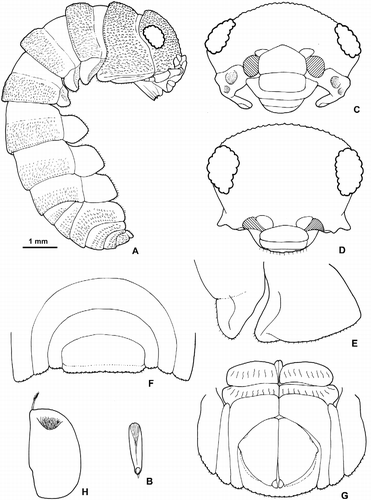
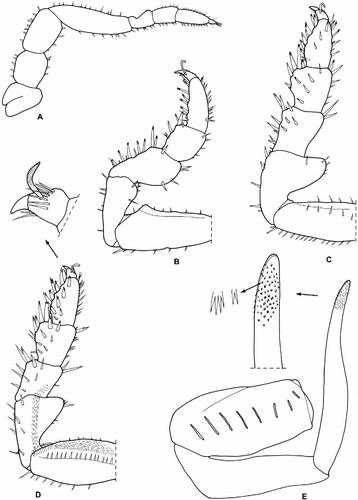
Tylos albidus; Schmalfuss & Vergara, Citation2000: 3; Schmalfuss Citation2003: 322.
Type material re-examined
India, Nicobar Islands: three specimens syntypes, leg. Galathea Expedition, 1846 (ZMUC CRU 1688).
Material examined
North Kaafu Atoll: Kudabandos, 6 ♂♂, 10 ♀♀, 22.XI.1992 (MZUF 4339). Vaavu Atoll: 2 ♀♀, 2 juvs, Kudhiboli, 28.XI.1993 (MZUF 9108); 3 ♀♀, Bodumohoraa, 6.XII.1993 (MZUF 9105); 1 ♂, 7 ♀♀, 1 juvs, Thinadhoo, 1–3.XII.1993 (MZUF 9107); 11 ♂♂, 10 ♀♀, Aarah, 29.XI.1993 (MZUF 9102); 3 ♂♂, 7 ♀♀, Foththeyo, 8.XII.1993 (MZUF 9103); 2 ♂♂, 12 ♀♀, Vashugiri, 28.XI.1993 (MZUF 9101); 1 ♂, 7 ♀♀, Felidhoo, 2.XII.1993 (MZUF 9106); 13 ♂♂, 12 ♀♀, Anbaraa, 2.XI.1994 (MZUF 9104).
Distribution
Previously known from the Nicobar Islands. Kwon (Citation1993) states that one of the syntypes (a female) of T. granuliferus Budde-Lund, Citation1885 from Borneo probably belongs to T. albidus. New record for the Maldives.
Remarks
Tylos albidus was described by Budde-Lund (Citation1885) after three specimens (here re-examined) collected during the first Galathea Expedition to the Nicobar Islands. Budde-Lund (Citation1906) briefly redescribed this species on the basis of the syntypes adding some illustrations. No other records are known about this species. As Budde-Lund's description is insufficient for a safe identification, a complete series of illustrations is provided here (Figures and ) based on the specimens from the Maldives which, after comparison, are morphologically indistinguishable from the type specimens. Tylos albidus belongs to the Indo-Pacific group of species together with T. minor Dollfus, Citation1893, T. opercularis Budde-Lund, Citation1885, T. nudulus Budde-Lund, Citation1906, and T. granuliferus Budde-Lund, Citation1885. It is characterized by the distinctly granulated dorsum, absence of paramedian tubercles on the telson, cephalon with frontal process not pointed posteriorly, epimera of pereonites 2–4 triangular, reduced point on the basis of pereopod 1, and strong enlargement of pereopods 5–7 ischium.
Family Styloniscidae
Genus Styloniscus Dana, Citation1852
Styloniscus maldivensisn. sp.
(Figures and )
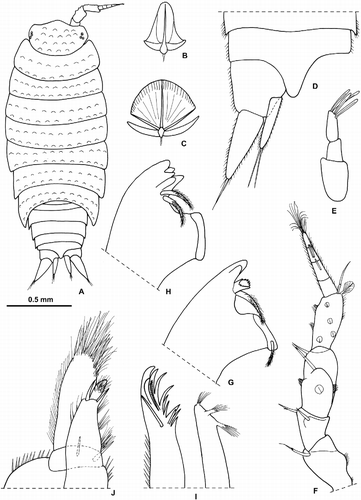
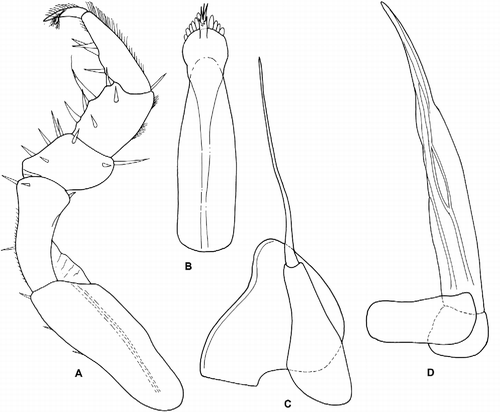
Material examined
Vaavu Atoll: ♂ holotype, 12 ♂♂, 3 ♀♀ paratypes, Felidhoo, 2.XII.1993 (MZUF 7702); 2 ♂♂, 2 ♀♀ paratypes, Hulhidhoo, 29.XI.1993 (MZUF 7703).
Description
Maximum length: ♂ and ♀, 1.7 mm. Pink color in vivo, colorless after conservation in alcohol. Body ovoid with pleon narrower than pereon (Figure ). Vertex and pereon distinctly granulated, pleon and telson smooth; dorsal surface with two types of scale-setae: lanceolate (Figure ) and fan-shaped (Figure ). Cephalon with obtuse frontal lobe slightly protruding compared with quadrangular lateral lobes; eye consisting of three small ommatidia in a triangle. Pleonites 3–5 with reduced posterior points. Telson (Figure ) with very narrow triangular distal part, narrowly rounded apex. Antennule (Figure ) with second article shorter than first and third; third article with four petaliform aesthetascs at apex. Antenna (Figure ) with flagellum longer than fifth article of peduncle; flagellum of four articles with the second and third bearing one and two aesthetascs, respectively. Right mandibles (Figure ) with one free penicil and a penicil on molar process; left mandible (Figure ) with two free penicils. Maxillule (Figure ) outer branch with 11 simple teeth and two long stalks; inner branch with three apical penicils. Maxilliped (Figure ) endite with a stout apical penicil; basal article of the palp with two setae.
Male. Pereopod 7 (Figure ) ischium with sternal margin slightly sinuous; merus quadrangular, shorter and wider than carpus. Genital papilla (Figure ) with rounded distal part bearing a row of lamellar scales on distal margin. Pleopod 1 (Figure ) exopodite as wide as long, with short, rounded posterior point, outer margin slightly sinuous; endopodite with flagelliform distal segment, about 1.5 times longer than basal one. Pleopod 2 (Figure ) exopodite very short, rectangular, about three times wider than long; endopodite with distal segment about eight times longer than basal one, with tapering apical part slightly bent outwards, acute apex.
Etymology
The species is named after the country of origin, the Maldives.
Remarks
The new species is characterized by the distinct tuberculation on the cephalon and pereon, very narrow distal part of the telson, antennule with four petaliform aesthetascs on the distal article, shape of the genital papilla, male pereopod 7, and pleopod 1. It shows its closest affinities with Styloniscus mauritiensis (Barnard Citation1936) from Mauritius and Hawaii (Taiti and Ferrara Citation1983, Citation1991), but most probably widely distributed in the Indo-Pacific area. Styloniscus maldivensis is readily distinguishable from S. mauritiensis by the male pereopod 7 ischium with sinuous sternal margin and merus with no rounded lobe, shape of the distal part of the genital papilla, and the male pleopod 1 exopodite with sinuous instead of straight outer margin.
Family Olibrinidae
Genus Olibrinus Budde-Lund, Citation1913
Olibrinus antennatus (Budde-Lund, Citation1902)
Material examined
North Kaafu Atoll: many ♂♂ and ♀♀, Huraa, 22.XI.1992 (MZUF 4341). Vaavu Atoll: 9 ♂♂, 19 ♀♀, Rakeedhoo, 4.XII.1993 (MZUF 9046); 8 ♂♂, 11 ♀♀, Felidhoo, 2.XII.1993 (MZUF 9045).
Distribution
This amphibious species is common along the coasts of the Indian Ocean where it occurs in mangrove areas and under coral rocks. It is recorded with certainty from the Red Sea, Djibouti, Somalia, Socotra Island, Chagos Islands, Mozambique, Madagascar, Nicobar Islands, and Malay Peninsula. New record for the Maldives.
Remarks
Olibrinus antennatus and its complex synonymy have been discussed in Taiti and Ferrara (Citation2004). From the original description and figures, it is very probable that also Olibrinus ormaraensis Kazmi, Citation2004 from Pakistan is a junior synonym of O. antennatus.
Family Detonidae
Genus Armadilloniscus Uljanin, Citation1875
Armadilloniscus quadricornis Vandel, Citation1970
Material examined
North Kaafu Atoll: many ♂♂ and ♀♀, Huraa, 22.XI.1992 (MZUF 4336). Vaavu Atoll: 6 ♂♂, 2 ♀♀, 2 juvs, Felidhoo, 2.XII.1993 (MZUF 8980); many ♂♂ and ♀♀, Anbaraa, 2.XII.1994 (MZUF 8979).
Distribution
This halophilic species was previously known from Malaysia, Indonesia, New Guinea, and Solomon Archipelago. New record for the Maldives.
Remarks
For illustrations and comments on this and the following species of Armadilloniscus, see Taiti and Ferrara (Citation1989).
Armadilloniscus mirabilis Ferrara, Citation1974
Material examined
Vaavu Atoll: many ♂♂ and ♀♀, Fulidhoo, 30.XI.1993 (MZUF 8969); 6 ♂♂, 8 ♀♀, 3 juvs, Thinadhoo, 1–3.XII.1993 (MZUF 8948); many ♂♂ and ♀♀, Bodumohoraa, 6.XII.1993 (MZUF 8947); 1 ♀, Anbaraa, 2.XII.1994 (MZUF 8946).
Distribution
Previously known from Somalia and Malaysia. New record for the Maldives.
Armadilloniscus biltoni Taiti & Ferrara, Citation1989
Material examined
Vaavu Atoll: 11 ♂♂, 11 ♀♀, Kunavashi, 7.XII.1993 (MZUF 9013).
Distribution
This species was previously known only from the Togian Islands (Sulawesi, Indonesia). New record for the Maldives.
Family Incertae sedis
Genus Buchnerillo Verhoeff, Citation1942
Remarks
The genus Buchnerillo was included by Verhoeff (Citation1942) and Vandel (Citation1945, as Lereboulletian. gen.) in the section Synocheta, family Buddelundiellidae. Vandel (Citation1960) established the synonymy between Buchnerillo and Lereboulletia, and created for Buchnerillo the new subfamily Buchnerilloninae within the family Buddelundiellidae. Taiti and Ferrara (Citation1991; Citation1996) considered Buchnerillo to belong to an “undetermined family” while Tabacaru (Citation1993) pointed out that this genus, considering the structure of mouth parts and the eye with more than three ommatidia, is neither related to Buddelundiella Silvestri, Citation1897, nor to any of the other Synocheta. This opinion was followed also by Schmalfuss (Citation2003) who suggested that the genus might be included in the family Detonidae, section Crinocheta, on the basis of the eyes with more than three ommatidia, structure of antennule, antenna, maxillula, and pereopods. Until a detailed study on this genus, using also molecular tools, is performed to clarify its systematic position, I prefer to keep the genus Buchnerillo as incertae sedis. At present, the genus includes only two species, B. litoralis Verhoeff, Citation1942 from the Mediterranean coasts, Madeira, and Venezuela (this last record by Paoletti and Stinner Citation1989 needs to be confirmed), and Buchnerillo oceanicus (see below).
Buchnerillo oceanicus Ferrara, Citation1974
Material examined
Vaavu Atoll: 1 ♀, Kudhiboli, 28.XI.1993 (MZUF 7704); 3 ♀♀, Fulidhoo, 30.XI.1993 (MZUF 7705); 4 ♂♂, 3 ♀♀, Thinadhoo, 1–3.XII.1993 (MZUF 7706); 1 ♂, Bodumohoraa, 6.XII.1993 (MZUF 7707).
Distribution
Buchnerillo oceanicus was known with certainty only from the southern coast of Somalia. New record for the Maldives.
Family Alloniscidae
Genus Alloniscus Dana, Citation1854
Alloniscus pigmentatus Budde-Lund, Citation1885
Material examined
Vaavu Atoll: many ♂♂ and ♀♀, Rakeedhoo, 4.XII.1993 (MZUF 9050); many ♂♂ and ♀♀, Felidhoo, 2.XII.1993 (MZUF 9048); 2 ♂♂, 11 ♀♀, 1 juvs, Anbaraa, 2.XII.1994 (MZUF 9049).
Distribution
The species is known with certainty from Madagascar, Aldabra Island, Chagos, Comoro, Mozambique, and southern China (Hainan Dao). New record for the Maldives.
Remarks
For illustrations and comments on this species, see Ferrara and Taiti (Citation1985) and Kwon and Taiti (Citation1993). Borradaile (Citation1901: 99, Figure 23) described the new species A. maldivensis from Hedufuri, Mahlos Atoll, Maldive Islands. From this description, it is not possible to recognize the species. According to Budde-Lund (Citation1913), it might be a junior synonym of A. pigmentatus while Ferrara and Taiti (Citation1985) tentatively considered A. maldivensis as a possible synonym of A. nicobaricus Budde-Lund, 1985. As both A. pigmentatus and A. nicobaricus are present on the Maldives, it is impossible to attribute A. maldivensis to one of these two species without the re-examination of Borradaile's material. Due to these uncertainties, Schmalfuss (Citation2003) considered A. maldivensis as a nomen dubium.
Alloniscus nicobaricus Budde-Lund, Citation1885
Alloniscus nicobaricus; Ferrara and Taiti Citation1985: 295; Schmalfuss Citation2003: 12.
Material examined
Vaavu Atoll: many ♂♂ and ♀♀, Fulidhoo, 30.XI.1993 (MZUF 9042); 2 ♂♂, 4 ♀♀, 5 juvs, Thinadhoo, 1–3.XII.1993 (MZUF 9041).
Previous records
Maldive Islands (Ferrara and Taiti Citation1985).
Distribution
Known from the Maldives, north-eastern India, Nicobar Islands, and Andaman Islands.
Remarks
This species has been illustrated in Ferrara and Taiti (Citation1982, as A. pigmentatus) while its taxonomic status has been discussed in Ferrara and Taiti (Citation1985).
Family Stenoniscidae
Genus Metastenoniscus Taiti & Ferrara, Citation1982
Metastenoniscusosellai Taiti & Ferrara, Citation1982
Material examined
North Kaafu Atoll: 6 ♀♀, Kudabandos, 22.XI.1992 (MZUF 4342). Vaavu Atoll: 6 ♂♂, 14 ♀♀, Fulidhoo, 30.XI.1993 (MZUF 9019); 7 ♀♀, Fulidhoo, 1.XII.1994 (MZUF 9023); 6 ♀♀, Felidhoo, 2.XII.1993 (MZUF 9020); 4 ♂♂, 11 ♀♀, Thinadhoo, 1–3.XII.1993 (MZUF 9022); many ♂♂ and ♀♀, Foththeyo, 8.XII.1993 (MZUF 9021).
Distribution
Previously known from the Andaman Islands and Indonesia (Bali). New record for the Maldives.
Family Halophilosciidae
Genus Littorophiloscia Hatch, Citation1947
Littorophiloscia amphindica Taiti & Ferrara, Citation1986
Material examined
Vaavu Atoll: many ♂♂ and ♀♀, Hulhidhoo, 29.XI.1993 (MZUF 9017); many ♂♂ and ♀♀, Felidhoo, 2.XII.1993 (MZUF 9016); many ♂♂ and ♀♀, Rakeedhoo, 4.XII.1993 (MZUF 9015); 2 ♂♂, 1 ♀, Kunavashi, 7.XII.1993 (MZUF 9018); many ♂♂ and ♀♀, Hulhidhoo, 29.XI.1994 (MZUF 9014).
Distribution
Known from Tanzania (Zanzibar), Comoro Islands, Maldives, Indonesia (Bali), and Taiwan. New record for the Maldives.
Remarks
Borradaile (Citation1901) recorded P. gracilis from Mahlos and Addu atolls, and Philoscia sp. from Hedufuri, Mahlos Atoll. Most probably these specimens refer to species of Halophilosciidae or Philosciidae recorded in this paper.
Littorophiloscia tropicalis Taiti & Ferrara, Citation1986
Material examined
North Kaafu Atoll: 1 ♀, Medhufinolhu, 18.XI.1992 (MZUF 4333); 1 ♀, Huraa, 22.XI.1992 (MZUF 4332). Vaavu Atoll: 2 ♂♂, 3 ♀♀, Kudhiboli, 28.XI.1993 (MZUF 8989).
Distribution
Littorophiloscia tropicalis has a circumtropical distribution. It is recorded from the USA (Florida), Belize, Mexico, Venezuela, Brazil, Ascension Island, St. Helena Island, Cameroon, Sudan, Somalia, Socotra Archipelago, and India. New record for the Maldives.
Remarks
The female specimens from Medhufinolhu and Huraa cannot be identified with certainty. Considering the size, general shape of the body, particularly the shape of the telson, and the structure of the dorsal scale-setae, they most probably belong to L. tropicalis.
Littorophiloscia pallida Taiti & Ferrara, Citation1986
Material examined
Vaavu Atoll: 4 ♂♂, 9 ♀♀, Bodumohoraa, 6.XII.1993 (MZUF 8990).
Distribution
Previously known only from Thailand (eastern Malay Peninsula). New record for the Maldives.
Family Philosciidae
Genus Burmoniscus Collinge, Citation1914
Burmoniscus acutitelson (Ferrara & Taiti, Citation1983)
Material examined
Vaavu Atoll: 15 ♂♂, 21 ♀♀, Hulhidhoo, 29.XI.1993 (MZUF 8999).
Distribution
Previously known only from the Seychelles. New record for the Maldives.
Burmoniscus javanensis (Richardson Searle, Citation1922)
Material examined
Vaavu Atoll: 1 ♂, Fulidhoo, 30.XI.1993 (MZUF 8977); 1 ♀, same locality, 1.XII.1994 (MZUF 8974); 4 ♂♂, 11 ♀♀, 9 juvs, Felidhoo, 2.XII.1993 (MZUF 8975, 8976); 1 ♂, 1 ♀, same data (SMNS 12124); many ♂♂ and ♀♀, Thinadhoo, 1–3.XII.1993 (MZUF 8973, 8978).
Distribution
This species has a wide distribution in the tropical area of the Indian and Pacific oceans. It is known from Réunion Island, India, Indonesia (Java, Bali, and Sulawesi), Malaysia, New Guinea, southern China, Hong Kong, and Taiwan. New record for the Maldives.
Burmoniscusbartolozzii Taiti & Manicastri, Citation1988
Material examined
Vaavu Atoll: 2 ♂♂, Vashugiri, 28.XI.1993 (MZUF 8983); many ♂♂ and ♀♀, Hulhidhoo, 29.XI.1993 (MZUF 8985); many ♂♂ and ♀♀, Felidhoo, 2.XII.1993 (MZUF 8982, 8984); many ♂♂ and ♀♀, Bodumohoraa, 6.XII.1993 (MZUF 8986); many ♂♂ and ♀♀, Thinadhoo, 1–3.XII.1993 (MZUF 8981, 8987); many ♂♂ and ♀♀, Foththeyo, 8.XII.1993 (MZUF 8988).
Distribution
Previously known from Sri Lanka. New record for the Maldives.
Burmoniscus meeusei (Holthuis, Citation1947)
Material examined
Vaavu Atoll: 2 ♂♂, 3 ♀♀, 3 juvs, Felidhoo, 2.XII.1993 (MZUF 8972); 5 ♂♂, 8 ♀♀, 7 juvs, Thinadhoo, 1–3.XII.1993 (MZUF 8970, 8971).
Distribution
This species was described on specimens collected in greenhouses of the Royal Botanic Garden at Kew, England, and then it has been recorded from Taiwan, Hawaii Islands and Brazil. New record for the Maldives.
Genus Anchiphiloscia Stebbing, Citation1908
Anchiphiloscia pilosa (Budde-Lund, Citation1913)
Material examined
North Kaafu Atoll: 1 ♂, Medhufinolhu, 18.XI.1992 (MZUF 4337). Vaavu Atoll: 4 ♀♀, Hulhidhoo I., 29.XI.1993 (MZUF 8967); 4 ♂♂, 14 ♀♀, 6 juvs, Hulhidhoo, 29.XI.1994 (MZUF 8968); 6 ♂♂, 11 ♀♀, Thinadhoo, 1–3.XII.1993 (MZUF 8965, 8966).
Distribution
This species is known from the Chagos Islands, West Malaysia, Indonesia (Java, Bali, and Krakatau), and Hawaii Islands. It has been recorded also from greenhouses in Amsterdam. New record for the Maldives.
Family Platyarthridae
Genus Platyarthrus Brandt, Citation1833
Platyarthrus acropyga Chopra, Citation1924
(Figure )
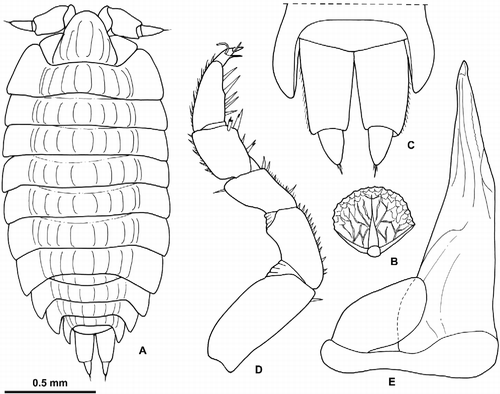
Material examined
North Kaafu Atoll: 1 ♂, Kudabandos, 22.XI.1992 (MZUF 4343). Vaavu Atoll: 2 ♂♂, 2 ♀♀, Vashugiri, 28.XI.1993 (MZU 9002); 1 ♀, same data (SMNS 12127).
Distribution
Previously known from north-eastern India. New record for the Maldives.
Remarks
These specimens (about 1.7 mm long) are identified as P. acropyga described from Barkuda Island, north-eastern India, as they correspond in every detail to the original description given by Chopra (Citation1924). The main diagnostic characters of this species are illustrated in Figure for future recognition. Platyarthrus acropyga seems to belong to the schoblii group, and shows affinities with P. almanus Verhoeff, Citation1949 from western and southern Turkey, Lebanon and northern Israel. The presence of an apparently native species of the genus Platyarthrus in the Indian subcontinent is most surprising. The genus, in fact, is mostly distributed in the Mediterranean subregion, with the easternmost record from south-western Turkmenistan (P. mesasiaticus Borutzky, Citation1976). As already pointed out by Vandel (Citation1962: 443), at the moment it is not possible to say whether this species is native or introduced into India. Its presence on the Maldives is probably due to introduction.
Family Trachelipodidae
Genus Nagurus Holthuis, Citation1949
Nagurus nanus (Budde-Lund, Citation1908)
Material examined
North Kaafu Atoll: 12 ♂♂, 6 ♀♀, Medhufinolhu, 18.XI.1992 (MZUF 4327); 1 ♂, Kudabandos, 22.XI.1992 (MZUF 4328). Vaavu Atoll: 6 ♂♂, 2 ♀♀, Fulidhoo, 30.XI.1993 (MZUF 9024); 1 ♀, Felidhoo I., 2.XII.1993 (MZUF 9025).
Distribution
Pantropical.
Nagurus kensleyi Ferrara & Taiti, Citation1985
Material examined
North Kaafu Atoll: 3 ♂♂, 2 ♀♀, 1 juv., Medhufinolhu, 18.XI.1992 (MZUF 4325); 5 ♂♂, 2 ♀♀, 9 juvs, Kudabandos, 22.XI.1992 (MZUF 4326). Vaavu Atoll: 1 ♂, 1 juv., Kudhiboli, 28.XI.1993 (MZUF 8960); many ♂♂ and ♀♀, Fulidhoo, 30.XI.1993 (MZUF 8962); 2 ♂♂, 2 ♀♀, Felidhoo, 2.XII.1993 (MZUF 8959); 2 ♂♂, 1 ♀, Anbaraa, 2.XII.1994 (MZUF 8961).
Distribution
Previously known only from Aldabra Island. New record for the Maldives.
Family Porcellionidae
Genus Porcellionides Miers, Citation1877
Porcellionides pruinosus (Brandt, Citation1833)
Material examined
North Kaafu Atoll: 3 ♂♂, Medhufinolhu, 18.XI.1992 (MZUF 4338).
Distribution
Cosmopolitan species of Mediterranean origin. New record for the Maldives.
Family Agnaridae
Genus Agnara Budde-Lund, Citation1908
Agnara taprobanica Ferrara & Argano, Citation1989
Material examined
North Kaafu Atoll: many ♂♂ and ♀♀, Medhufinolhu, 18.XI.1992 (MZUF 4340). Vaavu Atoll: many ♂♂ and ♀♀, Fulidhoo, 30.XI.1993 (MZUF 8993).
Distribution
Known from Sri Lanka and the Maldives.
Remarks
Borradaile (Citation1901: 99, Fig. 22) described P. maldivensis from Mafaro, Miladumadulu Atoll ( = Maafaru, Noonu Atoll), Maldive Islands, a species that Budde-Lund (Citation1913: 370) tentatively synonymized with A. madagascariensis (Budde-Lund, Citation1885). Considering that only A. taprobanica has been collected on these islands, it is possible that P. maldivensis corresponds to this species. The re-examination of type specimens of P. maldivensis is necessary to definitely clarify the taxonomy of this species.
Family Eubelidae
Genus Eubelinumn. gen.
Type-species: Eubelinum incertumn. sp.
Diagnosis
Minute size. Animals able to roll up into a perfect ball, vertical epimera. Dorsum with inconspicuous triangular scale-setae. One line of noduli laterales per side inserted more or less at the same distance from the lateral margin of pereonites. Cephalon with no frontal margin and no interocular line; small and rounded lateral lobes. Pereonite 1 with sulcus arcuatus wide and slightly arched, distant from the lateral margin and not reaching the anterior margin of the segment; lateral part slightly swollen; a schisma at posterolateral corners. Pereonite 2 ventrally with a transversal thickening on epimeron. Telson with trapezoidal distal part. Antennule with third segment apically truncate and bearing petaliform aesthetascs. Antennal flagellum with two articles. Mandible with molar penicil semidichotomized. Maxillule with outer branch bearing 4+5 teeth, all apically not indented; inner branch with two long penicils. Maxilliped with two triangular points on endite distal margin. All pleopods with monospiracular covered lungs and no visible perispiracular area. Uropod with very small exopodite dorsally inserted.
Etymology
The name is the diminutive of Eubelum Budde-Lund, Citation1885, type genus of the family Eubelidae. It refers to the small size of the type species of the genus. Gender neuter.
Remarks
For the structure of the antenna, buccal pieces, and number and type of the pleopodal lungs, Eubelinum shows affinities with the genera Xeroniscus Ferrara & Taiti, Citation1990, Omanodillo Taiti, Ferrara & Davolos, Citation2000, and Somalodilloides Taiti & Ferrara, Citation2004, all genera distributed in the Horn of Africa and the Arabian Peninsula. The new genus is readily distinguished from Xeroniscus and Omanodillo in having a schisma at the posterolateral corner of pereonite 1; from Somalodilloides by the cephalon with no frontal shield and frontal margin, sulcus arcuatus not reaching the anterior margin of pereonite 1, the epimeron of pereonite 2 ventrally with a transversal thickening instead of a rounded lobe, the antennule with a truncate apical margin, and the pleopodal lungs without perispiracular area.
Eubelinum incertumn. sp.
(Figures and )
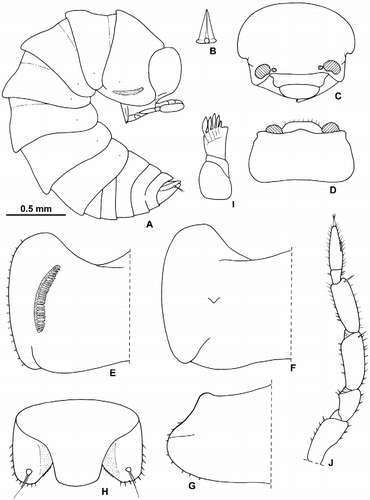
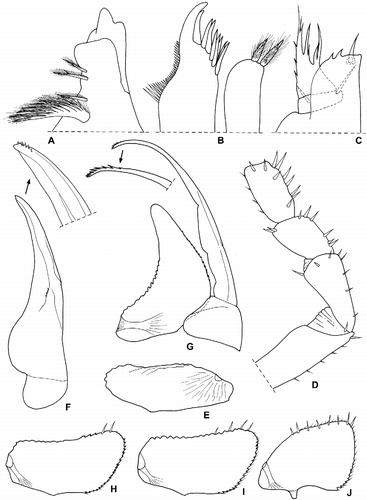
Material examined
Vaavu Atoll: ♂ holotype, 12 ♂♂, 31 ♀♀ paratypes, Hulhidhoo, 29.XI.1994 (MZUF 9439); 1 ♀ paratype, same locality, 29.XI.1993 (MZUF 9440).
Description
Maximum dimensions: ♂, 2.0 mm × 0.7 mm; ♀, 2.5 mm × 0.9 mm. Body very convex with smooth dorsum (Figure ). Colorless. Dorsum with small, scattered triangular scale-setae about twice as wide as long (Figure ). Cephalon (Figure ,D) about twice as long as wide, with profrons slightly protruding frontwards; eyes absent. Pereonite 1 (Figure ,F) with anterior corners broadly rounded, sulcus arcuatus covered by a line of scales, schisma with rounded lobes of subequal length. Pereonites 2 (Figure ), 3 and 4 with rounded epimera. Telson (Figure ) almost 1.5 times wider than long, with sinuous lateral margins and slightly convex apex. Antennule (Figure ) with second segment much shorter than first and third; apex with five aesthetascs. Antenna (Figure ) with second article of flagellum three times as long as first, equipped with 2–3 aesthetascs. Right mandible with 1+1 penicils, left mandible (Figure ) with 2+1 penicils. Maxillule (Figure ) outer branch with sinuous outer margin; inner branch with rounded apex and no posterior point. Maxilliped (Figure ) endite with anteromedial corner at right angle, basal article of palp with two long setae. Uropods (Figure ) with small exopodite, as wide as long, bearing two long apical setae.
Male. Pereopods without distinct sexual specializations. Pereopod 7 (Figure ) ischium with sternal margin straight. Pleopod 1 exopodite (Figure ) reniform, about three times as wide as long, without posterior point; endopodite (Figure ) with distal part slightly bent outwards, with some short subapical spines. Pleopod 2 (Figure ) endopodite much longer than exopodite, equipped with some denticles on the apical part. Pleopods 3–5 exopodites as in Figure –J.
Etymology
Latin incertus = uncertain. The name refers to the uncertain geographical origin of the species.
Remarks
Certainly, this new species is not autochthonous in the Maldives. Considering the affinities of the genus, its country of origin is probably East Africa or the Arabian Peninsula.
Family Armadillidae
Genus Cubaris Brandt, Citation1833
Cubaris murina Brandt, Citation1833
Cubaris murinus; Borradaile, Citation1901: 100.
Cubaris murina; Budde-Lund, Citation1913: 370.
Material examined
North Kaafu Atoll: many ♂♂ and ♀♀, Medhufinolhu, 18.XI.1992 (MZUF 4335); 1 ♂, Kudabandos, 22.XI.1992 (MZUF 4334). Vaavu Atoll: 1 ♂, 2 ♀♀, Hulhidhoo, 29.XI.1993 (MZUF 9062); 1 ♂, 1 ♀, Fulidhoo, 30.XI.1993 (MZUF 9060); 1 ♂, 3 ♀♀, Felidhoo, 2.XII.1993 (MZUF 9063); 2 ♂♂, 5 ♀♀, 5 juvs, Thinadhoo, 1–3.XII.1993 (MZUF 9064); 1 ♂, Alimathaa, 5.XII.1993 (MZUF 9061).
Previous records
Addu Atoll, Maldive Islands (Borradaile Citation1901).
Distribution
Pantropical.
Genus Pseudodiploexochus Lewis, Citation1998
Remarks
The genus Pseudodiploexochus was erected by Arcangeli (Citation1934) to accommodate three species (Diploexochus tabularis, D. ecaudatus, and D. albanyensis) described by Barnard (Citation1932) in the genus Diploexochus Brandt, Citation1833. As Arcangeli did not choose any type species for Pseudodiploexochus, this name was unavailable according to Art. 13.3 of the ICZN (Citation1999). In order to revalidate that name, D. tabularis Barnard, Citation1932 was chosen as the type species of the genus Pseudodiploexochus by Taiti et al. (Citation1998). In the same year, Lewis (Citation1998) had also revalidated Pseudodiploexochus by choosing D. tabularis as the type species. As the paper by Lewis was published on 27 October while that by Taiti et al. in November 1998, according to the law of priority the authorship of Pseudodiploexochus is Lewis, Citation1998.
At present, the genus Pseudodiploexochus includes 28 species (including the species described here) with a wide distribution from Brazil to Australia. Many species are morphologically very similar to each other and the best characters to distinguish species are the development, number, and disposition of dorsal tubercles.
Pseudodiploexochus indicusn. sp.
(Figure )

Material examined
Vaavu Atoll, ♂ holotype, 18 ♂♂, 21 ♀♀ paratypes, Hulhidhoo, 29.XI.1994 (MZUF 9441); 9 ♂♂, 8 ♀♀ paratypes, same locality, 29.XI.1993 (MZUF 9442); 8 ♂♂, 12 ♀♀ paratypes, Vashugiri, 28.XI.1993 (MZUF 9443); 5 ♂♂, 1 ♀ paratypes, Kudhiboli, 28.XI.1993 (MZUF 9444).
Description
Maximum dimensions: ♂, 2.0 mm × 0.8 mm; ♀, 2.5 mm × 1.0 mm. Pale color. Animals able to roll up into a perfect ball (Figure ). Dorsal cuticle with verruca-like protuberances among which are semicircular scale-setae (Figure ). Dorsal surface of pereon with inconspicuous tubercles, more pronounced on posterior pereonites, arranged as in Figure . Cephalon (Figure ,E) with frontal lamina straight, not bent over vertex, slightly depressed in the middle; frontal margin regularly convex; eye reduced, consisting of three small pigmented dots. Pereonite 1 (Figure ) with lateral margin not grooved, posterior margin straight; schisma shallow, with inner lobe broadly rounded and distinctly protruding backwards compared with outer lobe. Pereonite 2 (Figure ) with triangular epimera and rounded ventral lobe clearly visible in lateral view. Pereonites 3 and 4 with triangular epimera and 5–7 with quadrangular epimera. Telson (Figure ) with slightly concave sides, distal part wide with straight margin. Antenna with distal article of flagellum more than three times longer than proximal article. Uropod (Figure ) with protopodite about 3/5 as long as wide, distal margin straight in the part visible in dorsal view and slightly concave in the part covered by telson; exopodite absent as in all the species of the genus. No visible respiratory structures on pleopods.
Male. Pereopods with no sexual modifications. Pleopod 1 (Figure ) with exopodite very small, ovoid; endopodite with triangular distal part bent outwards. Pleopod 2 (Figure ) endopodite more than twice as long as exopodite; exopodite triangular with concave outer margin bearing three setae.
Etymology
Latin indicus = Indian. The name refers to the Indian Ocean where the Maldives are located.
Remarks
Pseudodiploexochus indicus is morphologically similar to P. mascarenicus Taiti & Ferrara, Citation1983 from Mauritius and P. tabularis (Barnard, Citation1932) from Cape Province, South Africa, and southern Brazil (introduced). It is readily distinguishable from P. mascarenicus by the reduced eye (eye with 4–5 ommatidia in P. mascarenicus), dorsal ornamentation with low but still visible tubercles, inner lobe of schisma rounded instead of triangular, and presence of the exopodite in the male pleopod 1 (absent in P. mascarenicus). It differs from P. tabularis (see redescription in Taiti and Ferrara Citation1979) in the number and disposition of the dorsal tubercles, inner lobe of the schisma on the pereonite 1 and ventral tooth of pereonite 2 more protruding backwards, and telson with wider distal part.
Discussion
Twenty-seven species of terrestrial isopods have been collected on the Maldive Islands: Ligia dentipes, Tylos albidus, Styloniscus maldivensisn. sp., Olibrinus antennatus, Armadilloniscus quadricornis, A. mirabilis, A. biltoni, Buchnerillo oceanicus, Alloniscus pigmentatus, Metastenoniscus osellai, Littorophiloscia amphindica,L. tropicalis, L. pallida, Burmoniscus acutitelson, B. javanensis, B.bartolozzii, B. meeusei, Anchiphiloscia pilosa, Platyarthrus acropyga, Nagurus nanus, N. kensleyi, Porcellionides pruinosus, Agnara taprobanica, Eubelinum incertumn. gen., n. sp., Cubaris murina, and Pseudodiploexocus indicusn. sp.
At least 13 species are littoral, halophilic, widely distributed on the coasts of the Indian Ocean or of the Indo-Pacific area (L. dentipes, T. albidus, O. antennatus, A. quadricornis, A. mirabilis, A. biltoni, B. oceanicus, A. pigmentatus, A. nicobaricus, M.osellai, L. amphindica, L. tropicalis, and L. pallida), six species have a wide distribution in the tropics (B. javanensis, B. meeusei, A. pilosa, N. nanus, and C. murina) or are cosmopolitan (P. pruinosus), two species are in common with Sri Lanka (B.bartolozzii and A. taprobanica), one species (P. acropyga) with India, and two with the granitic Seychelles (B. acutitelson) and Aldabra (N. kensleyi). The three new species (S. maldivensis, E. incertum, and P. indicus) are apparently endemic to the archipelago but most probably they will be found also in some of the other lands encompassing the Indian Ocean as soon as more accurate investigations are carried out. However, S. maldivensis and P. indicus belong to genera widespread in the southern hemisphere, while E. incertum shows affinities with other genera of Eubelidae present in East Africa and the Arabian Peninsula. All species have certainly colonized the archipelago by dispersal and/or introduction with human activities, given the oceanic origin of the archipelago.
Acknowledgements
The author thanks Ms Ilaria Checcucci (Florence) for technical assistance with drawings.
References
- ArcangeliA. 1934. Note di revisione sulla famiglia Armadillidae. Bollettino dei Musei di Zoologia ed Anatomia comparata della Regia Università di Torino. 44:83–119, pls 1–4.
- AudouinJV. 1826. Explication sommaire des planches de Crustacés de l'Égypte et de la Syrie, publiées par Jules-César Savigny, Membre de l'Institut, offrant un exposé des caractères naturels des genres, avec la distinction des espèces. In: Description de l'Égypte, ou recueil des observations et des recherches qui ont été faites en Égypte pendant l'expédition de l'Armée française, publié par les ordres de sa Majesté l'Empereur Napoléon le Grand. Histoire Naturelle 1 (4e partie):77–98.
- BarnardKH. 1932. Contributions to the crustacean fauna of South Africa. 11. Terrestrial isopoda. Annals of the South African Museum. 30:179–388.
- BarnardKH. 1936. Terrestrial isopods and amphipods from Mauritius. Isopoda. Annals of the Natal Museum. 8:1–12.
- BorradaileLA. 1901. Land Crustaceans. In: GardinerJS, editor. The fauna and geography of the Maldive and Laccadive archipelagoes: being the account of the work carried on and of the collections made by an expedition during the years 1899 and 1900. Vol. 1. Cambridge: Cambridge University Press, p. 64–100, pl. III.
- BorutzkyE. 1976. New data concerning the genus Platyarthrus Brandt (Isopoda, Oniscoidea) in the fauna of the USSR [Russian with English summary]. Zoologicheskii Zhurnal. 55:1097–1099.
- BrandtI. 1833. Conspectus Monographiae Crustaceorum Oniscodorum Latreillii. Byulleten moskovskogo Obshchestva Ispŷtateleĭ Prirodŷ. 6:171–193, pl. 4.
- Budde-LundG. 1885. Crustacea Isopoda terrestria per familias et genera et species descripta. Hauniae: Nielsen & Lydiche. p. 319.
- Budde-LundG. 1902. A list of terrestrial isopods. In: LanchesterW, editor. On the Crustacea collected during the Skeat Expedition to the Malay Peninsula. Proceedings of the Zoological Society of London. 1902:379–381.
- Budde-LundG. 1906. Die Landisopoden der Deutschen Südpolar-Expedition 1901–1903. Mit Diagnosen verwandter Arten. Deutsche Südpolar-Expedition. 9:69–92, pls 3–4.
- Budde-LundG. 1908. Isopoda von Madagaskar und Ostafrika. Mit Diagnosen verwandter Arten. In: VoeltzkowA, editor. Reise in Ostafrika in den Jahren 1903–1905. Wissenschaftliche Ergebnisse 2. Stuttgart: E. Schweizerbartsche Verlagsbuchhandlung. p. 265–308, pls 12–18.
- Budde-LundG. 1913. The Percy Sladen Trust expedition to the Indian Ocean in 1905, under the leadership of Mr J. Stanley Gardiner. (IV. No. XXII). Terrestrial Isopoda particularly considered in relation to the distribution of the southern Indo-Pacific species. Transactions of the Linnean Society of London. 15:367–394, pls 20–22.
- ChopraB. 1924. The fauna of an island in the Chilka Lake. On two myrmecophilous isopods from Barkuda. Records of the Indian Museum. 26:523–528.
- CollingeW. 1914. Zoological results of the Abor expedition 1911–1912. XXXVII. Terrestrial Isopoda. Records of the Indian Museum. 8:465–469, pls 31–33.
- DanaJD. 1852. On the classification of the Crustacea Choristopoda or Tetradecapoda. The American Journal of Science and Arts (Ser. 2). 14:297–316, 41.
- DanaJD. 1854. Catalogue and description of Crustacea collected in California by Dr John L. Le Conte. Proceedings of the Academy of Natural Sciences of Philadelphia. 7:75–177.
- DollfusA. 1893. Voyage de M. Charles Alluaud aux Iles Séchelles. Crustacés isopodes terrestres. Bulletin de la Société Zoologique de France. 18:186–190.
- FabriciusJC. 1798. Supplementum entomologiae systematicae. Hafniae: CG Proft & Storch; p. 296–306.
- FerraraF. 1974. Researches on the coast of Somalia. The shore and the dune of Sar Uanle. 3. Terrestrial isopods. Monitore Zoologico Italiano (Nuova Serie). Supplemento 5:191–220.
- FerraraF, ArganoR. 1989. Terrestrial isopods from Sri Lanka, V: Trachelipidae and Porcellionidae (Crustacea). Revue Suisse de Zoologie. 96:219–229.
- FerraraF, TaitiS. 1982. Ricerche zoologiche della “REEF 78” alle Andamane. VIII. Isopodi terrestri delle Isole Andamane. Bollettino del Museo civico di Storia naturale di Verona. 8(1981):459–492.
- FerraraF, TaitiS. 1983. Contributions à l'étude de la faune terrestre des îles granitiques de l'archipel des Séchelles. Isopodi terrestri. Annales du Musée Royal de l'Afrique Centrale, Série in-8, Sciences zoologiques. 240:1–92.
- FerraraF, TaitiS. 1985. The terrestrial isopods (Crustacea) of Aldabra. Zoological Journal of the Linnean Society. 85:291–315.
- FerraraF, TaitiS. 1990. A new genus of Eubelidae (Crustacea Isopoda Oniscidea) from the Horn of Africa and the Arabian Peninsula. Tropical Zoology. 3:89–105.
- HatchM. 1947. The Chelifera and Isopoda of Washington and adjacent regions. University of Washington Publications in Biology. 10:155–274, pls 1–18.
- HolthuisLB. 1947. On a small collection of isopod Crustacea from the greenhouses of the Royal Botanic Gardens. Annals and Magazine of Natural History. 13(11):122–137.
- HolthuisLB. 1949. The Isopoda and Tanaidacea of the Netherland, including the description of a new species of Limnoria. Zoologische Mededelingen. 30:163–190.
- ICZN. 1999. International Code of Zoological Nomenclature. 4th ed.. London: The International Trust for Zoological Nomenclature, xxix+306 p.
- KazmiQ. 2004. Two new species of littoral isopods (Crustacea) from Pakistan belonging to the genera Olibrinus and Armadilloniscus. Pakistan Journal of Marine Sciences. 13:41–48.
- KwonDH. 1993. Terrestrial Isopoda (Crustacea) from Korea. Korean Journal of Zoology. 36:133–158.
- KwonDH, TaitiS. 1993. Terrestrial Isopoda (Crustacea) from southern China, Macao and Hong Kong. Stuttgarter Beiträge zur Naturkunde (A). 490:1–83.
- LewisF. 1998. Oniscidea (Isopoda) from Lord Howe Island. Crustaceana. 71:743–777.
- MiersE. 1877. On a collection of Crustacea, Decapoda and Isopoda, chiefly from South America, with descriptions of new genera and species. Proceedings of the Zoological Society of London. 1877:653–679, pls 66–69.
- PaolettiMG, StinnerB. 1989. Two new terrestrial Isopoda from coralline cays of Venezuela‘s Caribbean coast. Proceedings of the Entomological Society of Washington. 91:71–80.
- Richardson SearleH. 1922. Terrestrial Isopoda collected in Java by Dr Edward Jacobson with descriptions of five new species. Proceedings of the United States National Museum. 60:1–7, pls 1–2.
- RouxP. 1828. Crustacés de la Méditerranée et de son littoral. Marseilles: Imprimerie d'Achard; p. 174, pls 1–45.
- SanthanakumarJ, MohanrajuR, KirubagaranR, SubramoniamT. 2014. Mate guarding behaviour in the supralittoral isopod, Ligia dentipes (Oniscidea) from the Andaman and Nicobar Islands. Invertebrate Reproduction & Development,. 10.1080/07924259.2013.870935.
- SchmalfussH. 2003. World catalog of terrestrial isopods (Isopoda: Oniscidea). Stuttgarter Beiträge zur Naturkunde (A). 654:1–341.
- SchmalfussH, VergaraK. 2000. The isopod genus Tylos (Oniscidea: Tylidae) in Chile, with bibliographies of all described species of the genus. Stuttgarter Beiträge zur Naturkunde (A). 612:1–42.
- SilvestriF. 1897. Res Ligusticae. XXVIII. Descrizione di un nuovo isopodo delle caverne liguri. Annali del Museo Civico Storia Naturale di Genova. 18(2):540–542.
- StebbingTRR. 1908. Zoological results of the third Tanganyika Expedition conducted by Dr. W.A. Cunnington, 1904–1905. Report on the Isopoda terrestria. Proceedings of the Zoological Society of London. 1908:554–560, pl. XXVII.
- TabacaruI. 1993. Sur la classification des Trichoniscidae et la position systématique de Thaumatoniscellus orghidani Tabacaru, 1973 (Crustacea, Isopoda, Oniscidea). Travaux de l'Institut de Spéologie Émile Racovitza. 32:43–85.
- TaitiS, FerraraF. 1979. Il genere Pseudodiploexochus Arcangeli, 1934 (Armadillidae, Oniscoidea, Isopoda). Revue de Zoologie Africaine. 93:151–184.
- TaitiS, FerraraF. 1982. Metastenoniscus osellai nuovo genere e nuova specie di isopodo terrestre (Stenoniscidae) dell‘Isola di Bali. Bollettino del Museo Civico di Storia Naturale di Verona. 8:443–452.
- TaitiS, FerraraF. 1983. Su alcuni isopodi terrestri della Réunion, di Mauritius e delle Seychelles. Revue Suisse de Zoologie. 90:199–231.
- TaitiS, FerraraF. 1986. Taxonomic revision of the genus Littorophiloscia Hatch, 1947 (Crustacea, Isopoda, Oniscidea) with description of six new species. Journal of Natural History. 20:1347–1380.
- TaitiS, FerraraF. 1989. New species and records of Armadilloniscus Uljanin 1875 (Crustacea Isopoda Oniscidea) from the coasts of the Indian and Pacific oceans. Tropical Zoology. 2:59–88.
- TaitiS, FerraraF. 1991. Terrestrial Isopods (Crustacea) from the Hawaiian Islands. Bishop Museum Occasional Papers. 31:202–227.
- TaitiS, FerraraF. 1996. The terrestrial Isopoda of Corsica (Crustacea, Oniscidea). Bulletin du Muséum National d'Histoire Naturelle Paris. 18:459–545.
- TaitiS, FerraraF. 2004. The terrestrial Isopoda (Crustacea: Oniscidea) of the Socotra Archipelago. Fauna of Arabia. 20:211–325.
- TaitiS, FerraraF, DavolosD. 2000. The terrestrial Isopoda (Crustacea: Oniscidea) of Oman. Fauna of Arabia. 18:145–163.
- TaitiS, ManicastriC. 1988. Terrestrial isopods from Sri Lanka, IV: Philosciidae (Crustacea, Oniscidea): part 2. Revue Suisse de Zoologie. 95:51–86.
- TaitiS, PaoliP, FerraraF. 1998. Morphology, biogeography, and ecology of the family Armadillidae (Crustacea, Oniscidea). Israel Journal of Zoology. 44:291–301.
- UljaninVN. 1875. Crustacea. In: FedtschenkoAP, editor. Reise in Turkestan von Alexis Fedtschenko auf Veranlassung des General-Gouverneurs von Turkestan, General von Kaufmann. Tom. II (Zoologischer Theil), Part 3: IV+61 pp., pls 1–13 [issued also in: Mémoires de la Société Impériale des Amis des Sciences Naturelles, d'Anthropologie et d'Ethnographie, Moscou11 (6)] (in Russian).
- VandelA. 1945. Isopodes terrestres récoltés par M. Remy au cours de son voyage en Corse. III. La famille des Buddelundiellidae. Archives de Zoologie Expérimentale et Générale. 84:100–113.
- VandelA. 1960. Isopodes terrestres (Première Partie). Faune de France. 64:1–416.
- VandelA. 1962. Isopodes terrestres (Deuxième Partie). Faune de France. 66:417–931.
- VandelA. 1970. Les isopodes terrestres des îles Rennell et Bellona. The natural History of Rennell Island, British Solomon Islands. 6:139–153.
- VerhoeffKW. 1942. Sphaeromiden-Studien und Buchnerillo n.g. Zeitschrift für Morphologie und Ökologie der Tiere. 39:153–175.
- VerhoeffKW. 1949. Über Land-Isopoden aus der Türkei. III. Revue Faculté des Sciences Université d'Istanbul (B). 14:21–48.
